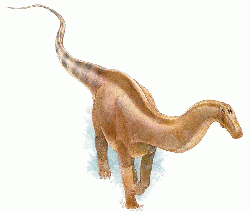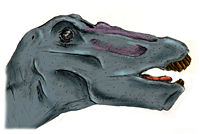Difference between revisions of "Apatosaurus" - New World Encyclopedia
Katya Swarts (talk | contribs) (Added article and credit tags) |
Rick Swarts (talk | contribs) |
||
| Line 10: | Line 10: | ||
| classis = [[Sauropsid]]a | | classis = [[Sauropsid]]a | ||
| superordo = [[Dinosaur]]ia | | superordo = [[Dinosaur]]ia | ||
| − | | ordo = [[Saurischia]] | + | | ordo = [[Saurischia]]* |
| − | | subordo = [[Sauropodomorpha]] | + | | subordo = [[Sauropodomorpha]]* |
| − | | infraordo = [[Sauropoda]] | + | | infraordo = [[Sauropoda]]* |
| − | | familia = [[Diplodocidae]] | + | | familia = [[Diplodocidae]]* |
| genus = '''''Apatosaurus''''' | | genus = '''''Apatosaurus''''' | ||
| genus_authority = [[Othniel Charles Marsh|Marsh]], 1877 | | genus_authority = [[Othniel Charles Marsh|Marsh]], 1877 | ||
| subdivision_ranks = [[Species]] | | subdivision_ranks = [[Species]] | ||
| subdivision = | | subdivision = | ||
| − | * ''A. ajax'' <small>( | + | * ''A. ajax'' <small>(type)</small> |
* ''A. excelsus'' <small>(Marsh, 1879c) Riggs, 1903</small> | * ''A. excelsus'' <small>(Marsh, 1879c) Riggs, 1903</small> | ||
* ''A. louisae'' <small>Holland, 1915</small> | * ''A. louisae'' <small>Holland, 1915</small> | ||
* ''A. parvus'' <small>(Peterson & Gilmore, 1902)<small> | * ''A. parvus'' <small>(Peterson & Gilmore, 1902)<small> | ||
| synonyms = | | synonyms = | ||
| − | * ''Brontosaurus'' <small> | + | * ''Brontosaurus'' <small>Marsh, 1879c</small> |
* ''Elosaurus'' <small>Peterson & Gilmore, 1902</small> | * ''Elosaurus'' <small>Peterson & Gilmore, 1902</small> | ||
}} | }} | ||
| − | '''''Apatosaurus''''' ( | + | '''''Apatosaurus''''' ([[Ancient Greek|Greek]] ἀπατέλος or ἀπατέλιος, meaning "deceptive" and σαῦρος meaning "lizard"), previously known as ''Brontosaurus'', is a [[taxonomgy#Scientific or biological classification|genus]] of [[sauropod]] [[dinosaur]]s that lived about 140 million years ago during the [[Jurassic]] period. They were some of the largest land [[animal]]s that ever existed, about 4.5 meters (15 feet) tall at the hips, with a length of up to 21 meters (70 feet) and a mass up to 35 metric tons (40 short tons, equal to 2,000 lb). |
| − | The cervical vertebrae and the bones in the legs were bigger and heavier than that of ''[[Diplodocus]]'' although, like Diplodocus, Apatosaurus also had both a long neck and a long tail. The tail | + | The cervical vertebrae and the bones in the legs were bigger and heavier than that of ''[[Diplodocus]]'' although, like Diplodocus, ''Apatosaurus'' also had both a long neck and a long tail. The tail is believed to have believed to have been held above the ground during normal locomotion. Like most sauropods (a suborder or infraorder of dinosaurs), ''Apatosaurus'' had only a single large claw on each forelimb. The skull was first identified in 1975, a century after this dinosaur acquired its name. |
| + | |||
| + | The name Apatosaurus means "deceptive lizard," so-named because the chevron bones (bones on underside of tail) were like those of ''[[Mosasaurus]]''. | ||
==Discovery and species== | ==Discovery and species== | ||
Revision as of 00:52, 18 March 2007
| Apatosaurus
| ||||||||||||||||||
|---|---|---|---|---|---|---|---|---|---|---|---|---|---|---|---|---|---|---|
 | ||||||||||||||||||
|
Extinct (fossil)
| ||||||||||||||||||
| Scientific classification | ||||||||||||||||||
| ||||||||||||||||||
| ||||||||||||||||||
|
Apatosaurus (Greek ἀπατέλος or ἀπατέλιος, meaning "deceptive" and σαῦρος meaning "lizard"), previously known as Brontosaurus, is a genus of sauropod dinosaurs that lived about 140 million years ago during the Jurassic period. They were some of the largest land animals that ever existed, about 4.5 meters (15 feet) tall at the hips, with a length of up to 21 meters (70 feet) and a mass up to 35 metric tons (40 short tons, equal to 2,000 lb).
The cervical vertebrae and the bones in the legs were bigger and heavier than that of Diplodocus although, like Diplodocus, Apatosaurus also had both a long neck and a long tail. The tail is believed to have believed to have been held above the ground during normal locomotion. Like most sauropods (a suborder or infraorder of dinosaurs), Apatosaurus had only a single large claw on each forelimb. The skull was first identified in 1975, a century after this dinosaur acquired its name.
The name Apatosaurus means "deceptive lizard," so-named because the chevron bones (bones on underside of tail) were like those of Mosasaurus.
Discovery and species
Fossils of this animal have been found in Nine Mile Quarry and Bone Cabin Quarry in Wyoming and at sites in Colorado, Oklahoma and Utah, USA.
- A. ajax is the type species of the genus, and was named by the paleontologist Othniel Charles Marsh in 1877 after Ajax, the hero from Greek mythology. It is the holotype for the genus and two partial skeletons have been found, including part of a skull.
- A. excelsus (originally Brontosaurus) was named by Marsh in 1879. It is known from six partial skeletons, including part of a skull, which have been found in the United States, in Oklahoma, Utah, and Wyoming.
- A. louisae was named by William Holland, in 1915. It is known from one partial skeleton, which was found in Colorado, in the United States.
Robert T. Bakker made A. yahnahpin the type species of a new genus, Eobrontosaurus in 1998, so it is now properly Eobrontosaurus yahnahpin. It was named by Filla, James and Redman in 1994. One partial skeleton has been found in Wyoming.
On March 23 1983 the Apatosaurus was made the official state dinosaur of Guam.
Paleobiology
Early on, it was believed that Apatosaurus was too massive to support its own weight on dry land, so it was theorized that the sauropod must have lived partly submerged in water, perhaps in a swamp. Recent findings do not support this. In fact, like its relative Diplodocus, Apatosaurus was a grazing animal with a very long neck and a long tail that served as a counterweight. Fossilized footprints indicate that it probably lived in herds. To aid in processing food, Apatosaurus may have swallowed gizzard stones (gastroliths) in the same way that many birds do today, as its jaws lacked molars with which to chew tough plant fibers.
Neck
Apatosaurus browsed the tops of trees, on riverbanks. Scientists believe that these sauropods could not raise their necks to an angle of 90 degrees, as doing so would slow blood flow to the brain excessively; blood starting at the body proper would take two or more minutes to reach the brain. Furthermore, studies of the structure of the neck vertebrae have revealed that the neck was not as flexible as previously thought.
Physiology
With such a large body mass, combined with a long neck, physiologists encounter problems determining how these animals managed to breathe.
Beginning with the assumption that Apatosaurus, like crocodilians, did not have a diaphragm, the dead-space volume (the amount of unused air remaining in the mouth, trachea and air tubes after each breath) has been estimated at about 184 liters for a 30 ton specimen.
Its tidal volume (the amount of air moved in or out during a single breath) has been calculated based on the following respiratory systems:
- 904 liters if avian
- 225 liters if mammalian
- 19 liters if reptilian
On this basis, its respiratory system could not have been reptilian, as its tidal volume would not have been able to replace its dead-space volume. Likewise, the mammalian system would only provide a fraction of new air on each breath. Therefore, it must have had either a system unknown in the modern world or one like birds, i.e. multiple air sacs and a flow-through lung.
Furthermore, an avian system would only need a lung volume of about 600 liters compared to a mammalian requirement of 2,950 liters, which would exceed the available space. The overall thoracic volume of Apatosaurus has been estimated at 1,700 liters allowing for a 500-liter, four-chambered heart (like birds, not three-chambered like reptiles) and a 900-liter lung capacity. That would allow about 300 liters for the necessary tissue.
Assuming Apatosaurus had an avian respiratory system and a reptilian resting-metabolism (it certainly could not fly), it would need to consume only about 262 liters (69 gallons) of water per day.
It is not known how Apatosaurs ate enough food to satisfy their enormous bodies. It is likely that they ate constantly, pausing only to cool off, drink or to remove parasites. It is surmised that they slept standing upright. They likely relied on their enormous size and herd behavior to deter predators.
Lips
According to Robert Bakker, it is a major possibility that Apatosaurus may have had thick, moose-like lips.[citation needed]
Tail
An interesting speculation was reported by the Discover Magazine in 1997 about "whipcracking" millions of years ago. Nathan Myhrvold, a computer scientist from Microsoft, carried out a computer simulation of the tail of Apatosaurus, a very long, tapering tail resembling a whip, and concluded that sauropods were capable of producing a crack of over 200 decibels, comparable to the sound of a cannon.[1]
Classification
Apatosaurus is a member of the Diplodocidae, along with Diplodocus, Barosaurus and Seismosaurus, although it is not as closely related to the others as they are to each other and hence placed in its own subfamily Apatosaurinae.[2][3]
Apatosaurus/Brontosaurus controversy
In 1877, Othniel Charles Marsh published notes on his discovery of Apatosaurus ajax. He followed this in 1879 with a description of another, more complete, dinosaur specimen. He speculated that the latter specimen represented a new genus and named it Brontosaurus excelsus. In 1903, it was discovered that Brontosaurus excelsus was in fact an adult Apatosaurus and the name Apatosaurus, having been published first, was deemed to have priority as the official name; Brontosaurus was relegated to being a synonym. In the 1970s, it was proven that the traditional "Brontosaurus" image known to all was, in fact, an Apatosaurus excelsus with a Camarasaurus head incorrectly placed on its body.[4]
See also
- Extinct animals in popular culture
Footnotes
- ↑ "Dinosaur in Motion", Discover November 1997
- ↑ Taylor, M.P. & Naish, D. 2005. The phylogenetic taxonomy of Diplodocoidea (Dinosauria: Sauropoda). PaleoBios 25(2): 1-7. (download here)
- ↑ Harris, J.D. 2006. The significance of Suuwassea emiliae (Dinosauria: Sauropoda) for flagellicaudatan intrarelationships and evolution. Journal of Systematic Palaeontology 4(2): 185–198.
- ↑ McIntosh JS. & Berman DS. (1975): Description of the palate and lower jaw of the sauropod dinosaur Diplodocus (Reptilia: Saurischia) with remarks on the nature of the skull of Apatosaurus. Journal of Paleontology 49(1): 187-199
Reference
Frank V. Paladino, James R. Spotila, Peter Dodson [1997]. "34: A Blueprint for Giants: Modeling the Physiology of Large Dinosaurs", in James O. Farlow and M.K. Brett-Surman: The Complete Dinosaur (in English). Indiana University Press, 491-504. 0253333490.
See also
Credits
New World Encyclopedia writers and editors rewrote and completed the Wikipedia article in accordance with New World Encyclopedia standards. This article abides by terms of the Creative Commons CC-by-sa 3.0 License (CC-by-sa), which may be used and disseminated with proper attribution. Credit is due under the terms of this license that can reference both the New World Encyclopedia contributors and the selfless volunteer contributors of the Wikimedia Foundation. To cite this article click here for a list of acceptable citing formats.The history of earlier contributions by wikipedians is accessible to researchers here:
The history of this article since it was imported to New World Encyclopedia:
Note: Some restrictions may apply to use of individual images which are separately licensed.


